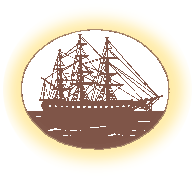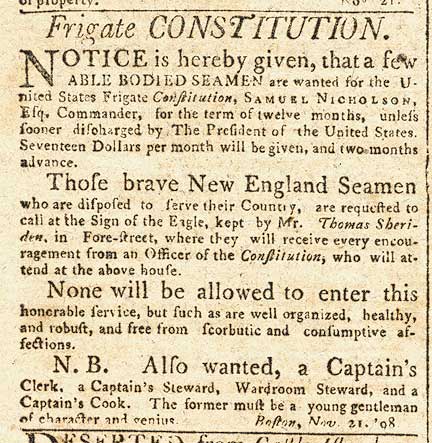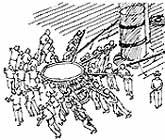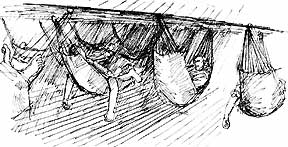
 |
 |
| Getting Started Key Words & Concepts Glossary Activities Recommended Resources Scuttlebutt | ||||
Getting Started  Ask students what the qualifications are to be in your class. Perhaps they had to pass the previous grade, live in a certain district or town, or pass a test. Who qualified to serve on Constitution? Make a list of student suggestions, which might include being strong, skilled or being a U.S. citizen. Then, read (with a flourish, if you can muster it) the recruiting notice below. You will need to “translate” the notice, because the letter “s” often resembles an “f” without its crossbar, a common printing style of the time. | ||||

Key Words and Concepts
You might ask those students who think they are qualified to join Constitution’s 19th century crew to line up on one side of the room. As a listening exercise, ask them the city, establishment, and street (Boston, Sign of the Federal Eagle, Fore Street)where they must go to apply. For those who didn’t line up, ask what disqualified them? Keep reworking the list on the board. Were girls allowed to serve? Or boys? How about African Americans, Latinos and Native Americans?

Tell the class that in the early years, the official record of who served aboard Constitution was not always accurate. Although over the years Navy Department policies have fluctuated for and against recruiting people of color, the Department estimates that about 10 percent of early navy crews were African Americans. Seafaring was one of the most common occupations for both free and enslaved African American men. Some of the original 13 states had offered freedom to slaves for enlisting in the states’ navies. Many of these men were later recruited by the U.S. Navy.
There were minorities aboard Constitution from the first day she went to sea. Her diversity reflected the composition of Boston’s growing population. By 1825, 27 different languages were spoken in the Boston area.
Although women did not officially become members of the crew until the 1980s, there is evidence that women disguised in men’s clothing did occasionally slip through the policy barrier and serve at sea. In England, Mary Lacey served in the Royal Navy under the name of William Chandler for years. When her identity was discovered in 1772, she was awarded a pension!
Boys as young as eight years old sailed as members of Constitution’s crew, though most boys aboard ship were teenagers. Their job during battle was to scramble down to the magazine, a chamber deep in the hold, to get cartridges of gun powder used to fire the cannon. This dangerous duty earned them the nickname powder monkey. There were also teenagers on board among the midshipmen or junior officers-in-training. Altogether, over 400 people served in Constitution’s first crew.
- recruit: to enroll/engage in military service
- crew: group of people working on a ship, sometimes including the officers
- hold: area below deck used to store materials, food and cargo
- rank: an official position or grade of an officer; rate is used for those
below officers
 |
| Constitution's crew slept in hammocks just inches apart from one another |
| K-4
5-8
9-12
|
 |
